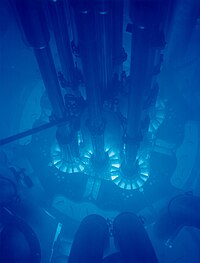
Photo from wikipedia
To the Editor — It has recently been proposed that Cherenkov luminescence from radionuclides can be used to activate tumour-localized photosensitizing nanoparticles (TiO2) and cause enhanced tumour cell death1. This… Click to show full abstract
To the Editor — It has recently been proposed that Cherenkov luminescence from radionuclides can be used to activate tumour-localized photosensitizing nanoparticles (TiO2) and cause enhanced tumour cell death1. This approach is proposed as a new method for circumventing the depth penetration limits of conventional light-based therapies. While the results of this study leave little doubt that radionuclides and photosensitizers interact in a synergistic manner, they do not prove that this interaction occurs through Cherenkov luminescence. Cherenkov luminescence is known to be an exceedingly dim phenomenon2. Average Cherenkov emission from 18F is approximately three photons per radioactive decay in water (refractive index n = 1.33) over the 250–800 nm range3. In terms of energy, Cherenkov light represents less than 0.006% of the total energy released during the radioactive decay of 18F. The vast majority of the energy (> 99.99%) is dissipated through molecular excitation, ionization, Bremsstrahlung radiation and heat. On average, a single 18F decay (250 keV) yields 6,800 hydroxyl radicals (OH•) through radiolysis of water4. These OH• radicals play a major role in mediating the biological action of ionizing radiation on DNA. For Cherenkov luminescence to produce a significant biological effect, its action on DNA must be comparable to or greater than that of 6,800 OH• radicals. However, due to the bandgap of TiO2 (3.2 eV), it is impossible for three Cherenkov photons to produce more than three OH• radicals. An alternative explanation for the observed increase in free radical production and cell death is that ionizing positrons interact directly with TiO2 nanoparticles to enhance cellular toxicity, without intervention of Cherenkov light. One simple way to test this alternative mechanism would be to irradiate the specimens with X-rays at energies below the Cherenkov threshold, with and without photosensitizer. It is also worth noting that a previous study reporting activation of TiO2 nanoparticles from radioactive 32P did not invoke Cherenkov luminescence as the mechanism of action5. ❐
Journal Title: Nature Nanotechnology
Year Published: 2018
Link to full text (if available)
Share on Social Media: Sign Up to like & get
recommendations!